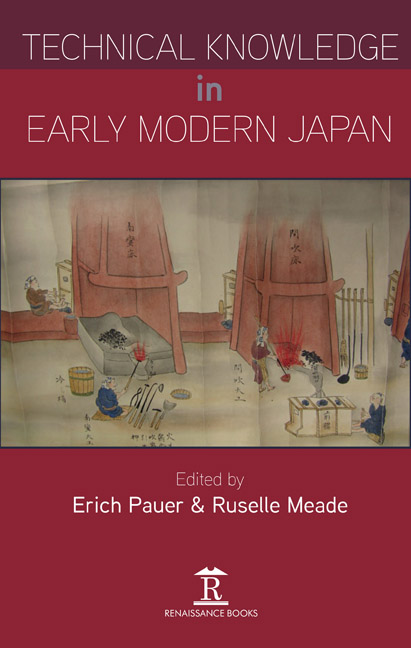Book contents
- Frontmatter
- Contents
- Acknowledgements
- Introduction: Remarks on the History of Technology in Japan
- 1 Production Techniques in Early Modern Japan as seen through ‘Famous Products of Japan from Mountain and Sea, Illustrated’ (Nippon sankai meisan zue, 1799)
- 2 Vehicles of Knowledge: Japanese Technical Drawings in the Pre-modern Era, 1600–1868
- 3 Dissemination of Knowledge and Technology: The Extensive Range of Exhibitions in Japan in the Eighteenth and Nineteenth Centuries
- 4 Knowledge on Mining and Smelting and Its Dissemination in the Edo Period
- 5 Tanaka Hisashige and His Myriad Year Clock: Its Technological Characteristics and Historical Background
- 6 A Statistical Analysis of Tōkyō Meikō Kagami (with a Focus on Highly Skilled Metalwork Craftsmen)
- 7 Boiler Manufacture in Late-nineteenth Century Japan: From First Beginnings to Nationwide Expansion
- Appendix: Selected Sources on the Japanese History of Technology (especially on series)
- List of Contributors
- Index
7 - Boiler Manufacture in Late-nineteenth Century Japan: From First Beginnings to Nationwide Expansion
Published online by Cambridge University Press: 30 April 2022
- Frontmatter
- Contents
- Acknowledgements
- Introduction: Remarks on the History of Technology in Japan
- 1 Production Techniques in Early Modern Japan as seen through ‘Famous Products of Japan from Mountain and Sea, Illustrated’ (Nippon sankai meisan zue, 1799)
- 2 Vehicles of Knowledge: Japanese Technical Drawings in the Pre-modern Era, 1600–1868
- 3 Dissemination of Knowledge and Technology: The Extensive Range of Exhibitions in Japan in the Eighteenth and Nineteenth Centuries
- 4 Knowledge on Mining and Smelting and Its Dissemination in the Edo Period
- 5 Tanaka Hisashige and His Myriad Year Clock: Its Technological Characteristics and Historical Background
- 6 A Statistical Analysis of Tōkyō Meikō Kagami (with a Focus on Highly Skilled Metalwork Craftsmen)
- 7 Boiler Manufacture in Late-nineteenth Century Japan: From First Beginnings to Nationwide Expansion
- Appendix: Selected Sources on the Japanese History of Technology (especially on series)
- List of Contributors
- Index
Summary
INTRODUCTION
TAKING BOILER MANUFACTURING techniques in nineteenth century Japan as its focus, this paper shows what features were considered most beneficial for the country as Western technology was imported, spread and took root, and what part engineers and craftsmen played in this sequence of events.
A boiler is essentially an apparatus formed of a furnace for generating pressurised steam with an accompanying pressure vessel, developed by the Englishman Thomas Savery (1650– 1715) shortly before the turn of the eighteenth century. As can be seen from illustrations of boilers of the time, there is a main unit made of copper with a brick cladding, to the bottom part of which heat is applied directly from the fire raised on a grate in which fuel is consumed, with ducting that allows the heated gases thus generated to make one pass round the main body and reheat it en route to a chimney. This method of construction assumes knowledge of the European practice of building an oven and a fireplace with bricks.
Steam was known in the Edo period but was only applied to distillation, which meant that boilers were not used in Japan until the middle of the nineteenth century. The art of brick making and bricklaying did not exist until then either, and there was no use made of chimneys. Contemporary ovens made of stones and clay had a common fire hole and smoke vent and the iron cauldron with which they were fitted could only be heated from below (Fig. 1).
By the time the skills needed to make and use boilers were introduced to Japan in the latter part of the nineteenth century boilers had already undergone 150 years of development and the task of designing them based on calculating their strength and efficiency fell to engineers familiar with the theory behind their construction. There were three technical requirements for boilers to be made in Japan: (1) to design them based on theoretical principles, (2) to make their main body out of metal and (3) to make and lay bricks well enough to build enclosing structures. Considerable damage was caused when boilers fractured and a system of regular inspections also had to be in place to prevent such accidents before they could be properly accepted.
- Type
- Chapter
- Information
- Technical Knowledge in Early Modern Japan , pp. 149 - 180Publisher: Amsterdam University PressPrint publication year: 2020



